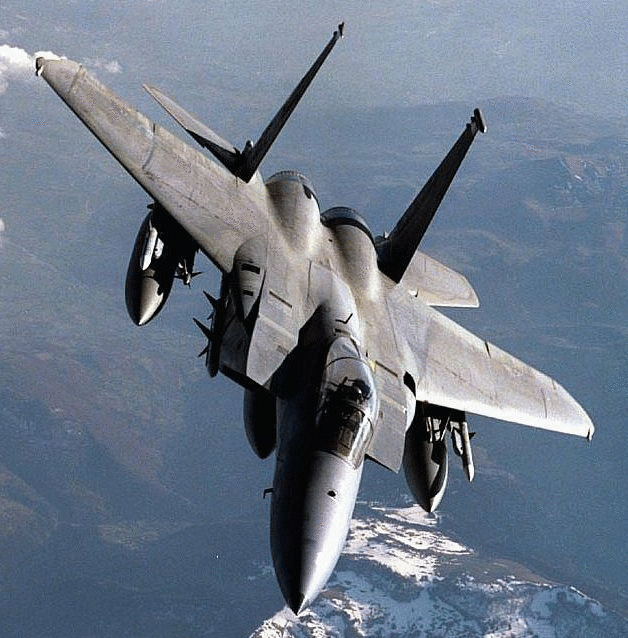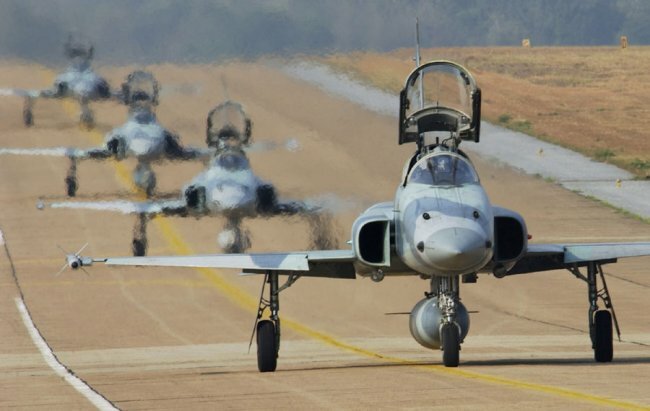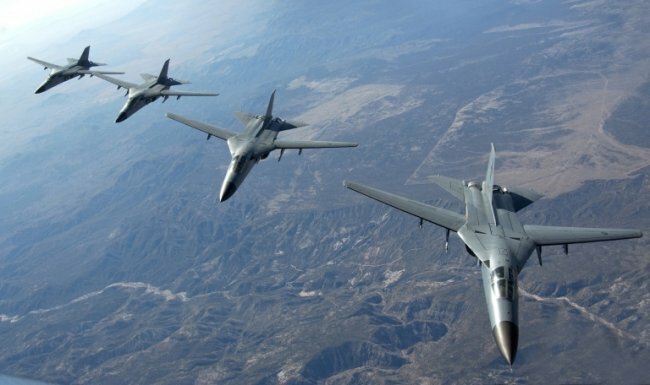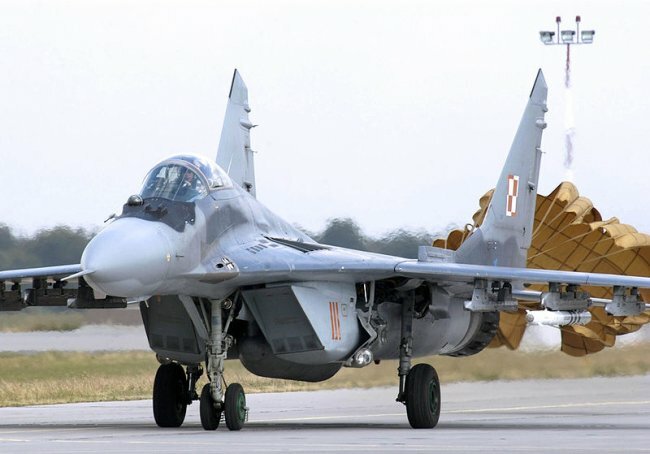"Aggressors"
In 1974, the study was completed, and on its basis, the Air Force Command made the most important conclusion: "It is necessary to revise the methodology for training pilots to conduct air combat in order to make it truly realistic."
Thus, the idea of creating a special unit capable of imitating the actions of enemy aircraft was born. At the same time, an 64 training squadron was formed, assigned to the Combat Operational Center weapons tactical fighter airbase Nellis (Nevada) and received the name "Aggressor".
Later, 65 Squadron (as part of the 57 Air Wing, based in Nevada), 26 Squadron (as part of the US Air Force in the Pacific, Clark Air Force Base in the Philippines) and 527 Squadron (in part of the 10 th tactical reconnaissance air wing of the 3 Air Force, US Air Force Command in the European zone, Alconbury Air Force Base in the UK).
These squadrons were armed with obsolete single-seat F-5E (Tiger-2) and two-seater F-5F (T-38) fighters, similar in their characteristics to the Soviet MiG-21 aircraft. In preparation for an air battle, “aggressor” fighters were usually equipped with one AIM-9P “Sidewinder” missile with a special homing head, which gave a signal to the pilot’s head phones at the moment when the target turned out to be “shot distance”. When evaluating the results of the battle, the receipt of this signal was counted as a defeat of the target.
Since the radar of the F-5E has a small target detection range, the fighter was aimed at the enemy from a ground control point. In this case, the process of guidance corresponded to the methodology adopted by the Air Force of the USSR and the Warsaw Pact countries. To heighten the credibility of the "aggressors" on the fuselages, Soviet designations and Soviet camouflage coloring were applied. The red stars on the wings and tail keel were already asking for, but for such a “demonstration of intentions” the authors of the concept did not have the audacity - instead of the red stars they drew the emblem of the 57 second wing - the target punctured by the charge of the canister.
Only the best of the best were selected for the Aggressor. Each candidate had to have an independent raid on jet fighters for at least 500 hours, the experience of a leading group and the qualification of an instructor pilot. Remarkably, the number of vacancies in the squadrons of the “aggressors” has always been less than the number of people willing to take them, because the competition in selecting candidates turned out to be extremely high.
As a rule, in the 64 and 65 training squadrons, six selected pilots were trained. The main stage of training at the Nellis base was preceded by a training course at the School for the Study of the Armed Forces of the Soviet Union and the Warsaw Pact countries, geographically located in the territory of the Bolling air base (Columbia).
During the training, each pilot had to take part in the 41 training flight and sit out an 121 hour of lectures devoted not only to the theory and tactical techniques of air combat adopted in the USSR Air Force, but also stories socialist countries, the current political situation and things like that.
Approximately half of the pilots who had been trained in the 64 and 65 squadrons remained to serve there, and the rest were sent to other training units of the air force.
The duration of service of the pilots in the squadrons "Aggressor" was usually three years, after which they returned to their combat units, where their experience was used to improve the level of training of flight personnel.
“Aggressors” were actively used in exercises of various sizes, during which the crews were in favor of a potential enemy, that is, by and large - for the USSR and the Warsaw Pact countries. Approximately half of the sorties were carried out directly at Nellis airbase as part of the famous and annually held Red Flag exercise.
Depending on the tasks worked out at the exercises, the “aggressor” planes acted in various roles. For example, if tactical fighters from a conventional unit flew with a combat load to attack ground targets, the “aggressors” acted as air defense fighters with the task of preventing the attack aircraft from breaking through to the target.
It is clear that the assessment of the work of any units of the Air Force is carried out on the basis of the quantitative and qualitative results of the air combat conducted by them. Therefore, the personnel are extremely interested in destroying as many of the aircraft of the opposing side as possible and strive to accomplish the task using all their capabilities. As noted in the western press, the actions of the Aggressor squadrons were very successful. This success was determined primarily by the high level of professional training of the pilots and their desire to win at all costs. Even when flying on outdated vehicles, the “aggressors” quite often “shot down” the most modern and well-armed fighters - such as the F-15 and F-16.

However, the desire to win at any cost often led pilots to risky situations. According to reports of Western military journals, the accident rate of flights in squadrons of the "Aggressor" is much higher than in conventional combat units. Even separate attempts of rams were recorded - when, finding themselves in a “stalemate”, pilots of training squadrons tried to take the enemy into fear, imitating a frontal attack with an inevitable collision.
* * *
If the United States Air Force “aggressors” were written in abundance at one time, without failing to point out that such a training method for flight personnel educates hatred towards the USSR and the entire socialist camp in American pilots, then the existence of similar units in the Soviet army was carefully hushed up.
Nevertheless, the experience of the wars in Vietnam and the Middle East made us think not only the American, but also the Soviet generals. Reports from the field indicated that the tactics of conducting air combat in the Soviet Air Force (namely, Vietnamese and Arab pilots passed our school) are outdated and do not meet the requirements of the time. It was then that it was decided to create a special group from among the most experienced fighter pilots of combat units.
At the beginning of 1970, on the basis of one of the fighter regiments of the Air Force of the Turkestan Military District, a pilot training center was organized, where pilots who were preparing to set off on “long-distance missions” began to hone their combat skills.
The Center had squadrons equipped with MiG-21PFM, MiG-21CM and MiG-21UM (UA) aircraft. The training was carried out according to the “Caucasus” program (“500 exercise”), which included working out single and group flights, complex and aerobatics, combat maneuvering, single and group maneuvering air battles at medium, small and extremely low altitudes.
By 1972, the Center released several groups of pilots who then took part in the hostilities in Egypt.
After the first successes, the command came to the conclusion that combat experience must be implemented in all air units. The center in Turkmenistan was redeveloped: two squadrons, along with other units and support and control units (including the “La-17” radio-controlled targets) unit, became part of the Air Force Base for the verification of combat training of combatant units of fighter aircraft.
The squadrons were manned by pilots with experience of air combat in Vietnam, the Middle East, and those of the young people who received training in the Caucasus program. It was with this elite aviation that pilots from all over the Soviet Union had to compete, from time to time visiting the Turkmen Base.
Thus began the nearly twenty-year history of the Soviet squadrons "Aggressor". Although the name never once appeared in any document, in the circle of military pilots these units were dubbed that way.
Like colleagues in the United States, Base pilots had the highest level of training, and it was not easy to "fight" with them.
Over time, the pilots who had real combat experience became less and less — they grew old and retired — and in the ranks they were replaced by pilots of the 1 class. Updated and technology. In the autumn of 1975, the second squadron of the Center received the MiG-23М and MiG-23UB aircraft. In 1987, the first squadron mastered the most modern fighter of the time - the MiG-29.
In the late eighties, an interesting problem arose: air regiments on fighters of the same type “local” were involved in checks at the Base. And the pilots, especially when performing group maneuver air battles, found it difficult to determine where is “their own” and where is “alien”. To solve the problem, the command decided to inflict a distinctive color on the airplanes belonging to Base: the so-called “cognac stripes” on the upper surfaces of the wings and the fuselage and the “shark mouth” in the nose. Already at the initiative of the pilots and technicians of the Base, unofficial symbols of training squadrons also emerged: the first had a leopard in a jump, the second had a viking with a baton. Both emblems, in spite of their comic nature, very much resemble the symbolism of some American divisions adoring aggressive images.
Time passed, and in the autumn of 1991, the second squadron was scheduled for retraining for Su-27 fighters, and the sketches of their “aggressive” coloring were ready. However, the collapse of the Soviet Union, which occurred in December of the same year, put an end to these plans. The Head of the Base, Colonel Konstantin Petrovich Morozov, became the Minister of Defense of Ukraine. The base was transferred first to the Armed Forces of the CIS, and then - under the jurisdiction of Russia, but in the territory of Turkmenistan ...
* * *
In October, 1990, after the unification of Germany, the aircraft of the Air Force of the National People’s Army of the GDR joined the Luftwaffe. Aircraft boards were decorated with crosses and new squadron emblems.
At first, the Luftwaffe command was quite skeptical of the Soviet fighters that were in service with the GDR Air Force, but, having estimated the economic aspects, decided to keep the MiG-24 fighter (29 single and 20 twin) in service with the Soviet production. The Russian-German joint venture MAPS (MIG Aircraft Product Support GmbH) was created for the technical support of the German MiGs in 4.
In the process of training battles with various Western-made fighter aircraft, it turned out that the MiG-29 is superior in number to its flight characteristics of American aircraft of the same class.
At the end of September 1998, the planned NATO military exercises were held in which the German MiG-29 won all the air battles with the American F-16, F-4, and French Mirage-2000 fighters .
The exercise revealed an “absolute superiority” (as the representative of the American command put it) of Russian aircraft over Western counterparts.
"One on one I will easily beat anyone - the commander of the 73 squadron of the Luftwaffe, Colonel Reinhard Mack, told reporters, - including F-15. The only exception may be the latest F-16. ”
The MiG-29 of the German Air Force was modernized to meet NATO standards. After that, for the first time, six cars took part in the American exercises “Red Flag” as “aggressors”. As these training battles showed, American fighters have an advantage at distances of 65 kilometers; as the distance decreases, the situation is leveling off, and the MiG looks more preferable on 17 kilometers.
Since Russia and the NATO countries are now considered allies, the communique on these exercises, which have become quite frequent, separately emphasized that the participation of German MiGs should not be regarded as preparation for war with our country - however, armed with countries declared enemies or " Potential opponents of the United States, you can see both MiGs and Su. Thus, during the war with Yugoslavia, NATO pilots shot down six "29 MiGs" belonging to the Serbian Air Force - training in games against the "aggressors" was not in vain.
Now the MiG-29 fighters are transferred by Germany to Poland. Warsaw is going to use these experienced fighters for five years, after which new ones will be purchased. The role of training "aggressors" goes to the Poles ...








Information